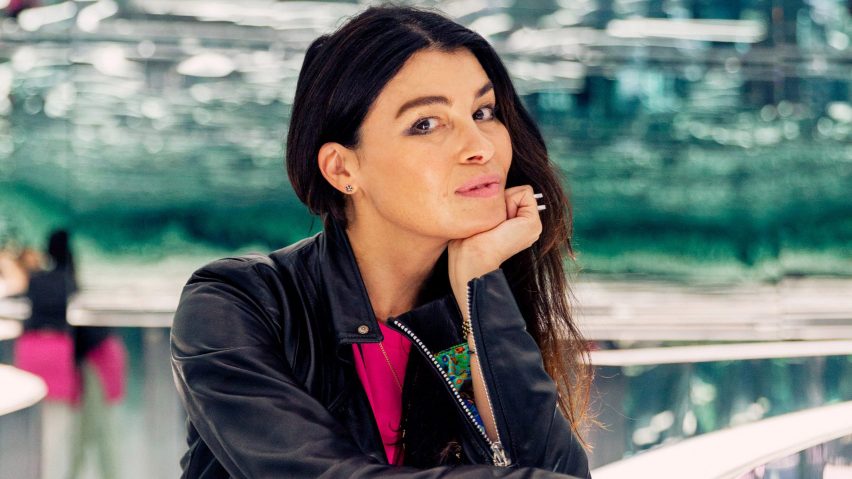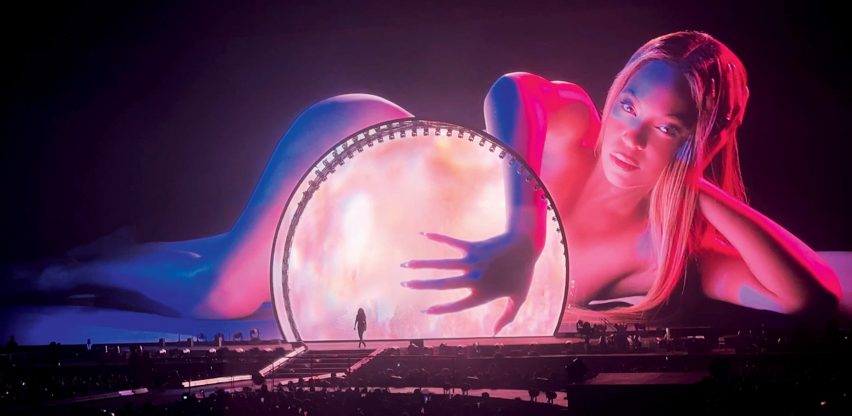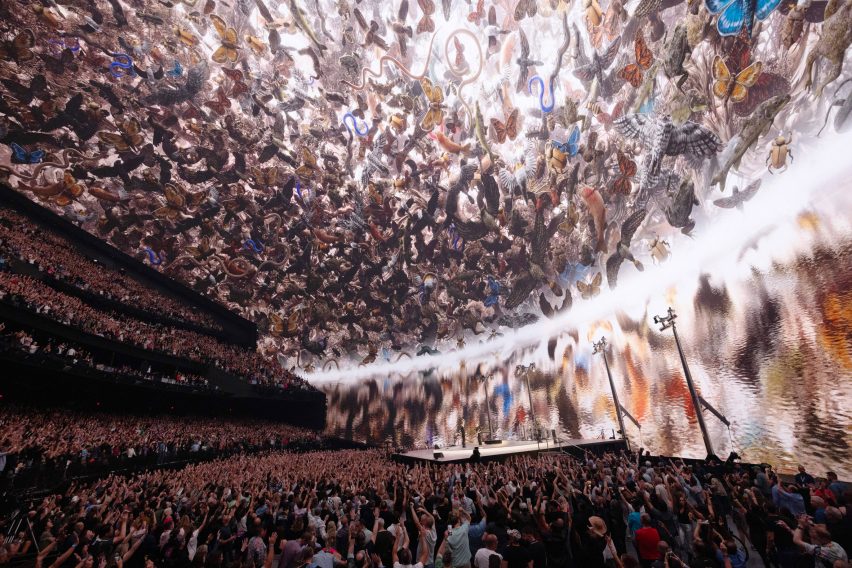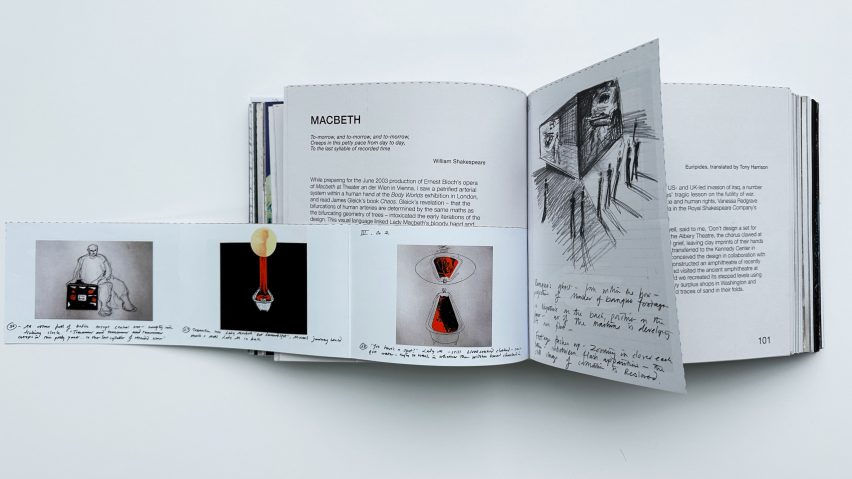
Las Vegas Sphere represents the "iPhone-ification" of tour design says Es Devlin
The Las Vegas Sphere could set a new standard for tour design much like the iPhone did for mobile phones, set designer Es Devlin tells Dezeen in this interview.
Devlin started her career in London's theatre scene of the 1990s before going on to conceive some of the most recognisable sets in the history of modern touring – from Kanye West's floating stages to Beyoncé's record-breaking Rennaisance world tour.
Her projects have ramped up in scale over the last three decades, culminating most recently in her contribution to U2's viral opening performance at the MSG Sphere in Las Vegas, which is billed as the world's largest spherical structure.
But no matter how big a venue or how monumental her stage design, Devlin says her work is not primarily about creating a spectacle.

Instead, she argues that tour design, since its inception, has been almost entirely about recapturing the feeling of closeness that audiences were first able to experience when watching giant acts like The Beatles and Elvis Presley on their TV.
"The reason that tour design came about on a mass scale was because singers had always sung, records had begun to be sold but the TV was what arrived in the 1950s," Devlin told Dezeen. "And it was this sense of intimacy in your own bedroom, in your own sitting room that a TV brought to an audience."
"The last 60 years has been about trying to emulate, through 75 or 17 or three trucks full of stuff – of speakers and screens and pyrotechnics and lighting – the intimacy that you achieve by sitting and watching the TV."
The Sphere is the "ne plus ultra" of tour design
With its giant 15,000-square-metre wraparound screen hiding nearly 160,000 speakers, Devlin argues Madison Square Garden's Sphere venue in Las Vegas is the closest that stage design has come to capturing this ideal.
"It has, in a way, done the final magic trick, which is to put the screen and the speaker as one unit," Devlin said. "So you do not see any speakers, you just see an almost infinite acreage of screen, in which the speakers are embedded."
"You're almost inside a film and the band are accompanying that film, and the band are augmented within that film through live relay."

Plans to erect a sister venue to the Sphere in London were recently put on ice after local councils, members of parliament and a 2,000-strong petition voiced concerns over the fact that its glowing LED exterior would prove disruptive to the local area.
But Devlin believes that at least the interior set-up pioneered by the Vegas venue could set a new standard for tour design, much like the iPhone did for mobiles.
"It's almost the iPhone-ification – in terms of a Jony Ive, ne plus ultra of phone design that then thereafter all phones will kind of emulate – it's almost that applied to tour design," Devlin said.
An Atlas of Es Devlin
Devlin spoke to Dezeen to mark the launch of her debut monograph, a 900-page tome titled An Atlas of Es Devlin that looks back at the last three decades of her career and took nearly seven years to complete.
The book compiles some 122 different projects, from her early work at London's National Theatre to designing catwalks for Louis Vuitton and Saint Laurent, two different Olympic ceremonies, various operas, a Superbowl halftime show and installations for the Tate Modern and the V&A.
"It's a small object compared to a stadium," Devlin said. "But the amount of energy myself and my team have put into it is as huge as any stadium show we've done."
"It's a black hole, in the way that it has contained a reverse Big Bang of everything we've done for 30 years, condensed into this one book."

The projects are presented first chronologically, through sketches and models from her archive, and later thematically through glossy photographs that reveal repeating forms and colours throughout her oeuvre.
"Every early version of this book felt kind of exhausting," she admits. "It was too many projects. It looked kind of interesting, maybe even kind of impressive because there was so much variety."
"But it didn't quite add up to a thesis or a nourishing read. It took a lot of time to find a form that might offer some kind of useful communication to a reader."
"We urgently need ritual"
Ultimately, Devlin hopes that accumulating her genre-bending work in one place will stand as a testament to the fact that designers today do not need to pick just one lane.
Instead, she says, they can and should be more "chameleon-like and amphibious", working across disciplines to serve as a model for how societal divides can be bridged.
"The more connectivity we have between art forms, the further we're likely to progress in these urgent conversations about understanding each other's point of view," Devlin said.
"Because you could argue that the crises we face now with what's going on in the Middle East, what's going on with our climate, what's going on with social inequity and the cost of living crisis, all of these could be said to stem from a lack of ability to see through the eyes of others. And that's what theatre has always been about – empathy."

Cultural gatherings, whether they are intimate plays or giant stadium concerts, have a unique ability to bring people together, she argues.
But so far, this function has largely been held back by seeing entertainment primarily as an industry, which is valued by the amount of money it generates rather than its larger societal impact.
"We urgently need ritual and we need ritual that isn't monetised," Devlin said.
"At the moment, we're feeling the pain of seeing the worst of what humans can do to each other," she said. "But if you can gather a group of human beings and invite them to all sing the same song, invite them to all feel the same thing, the best of humans comes out."